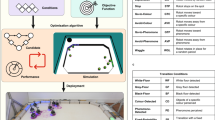Abstract
In the last decade, the development of multi robot systems has shown with growing evidence how a well-balanced deliberative-reactive coordination can provide a group of robots with an efficient and robust collective behavior. In this paper, we want to cover exhaustively this issue from the point of view of the single agent in the general model we have already presented as “roboticle framework”. Starting from a pure mechanical interpretation of an autonomous robot motion we shall understand the notions of stigmergy and affordance by maintaining at the sub-symbolic level all the relevant information useful to drive properly the robot while it participates to the collective action. Specifically, we shall focus on some interesting parameters through which the designer of the single robot governor’s unit could be helped to trigger its individual behavior within a collective scenario.
Access this chapter
Tax calculation will be finalised at checkout
Purchases are for personal use only
Similar content being viewed by others
Notes
- 1.
the roboticle.
- 2.
collapsed into a point.
- 3.
the velocity vector field of the robot.
- 4.
with u and v cartesian components of the robot speed V and steering \(\theta \).
- 5.
dissipative function.
- 6.
the dissipative function is taken with \(\tau _{1}=\tau _{2}=\tau \).
- 7.
namely, the vector velocity field animating the roboticle.
References
Gibson, J.J.: The Ecological Approach to Visual Perception. Psychology Pr (1979)
Gibson, J.J.: The theory of affordances. In Shaw, R., Bransford, J., eds.: Perceiving, Acting, and Knowing: Toward an Ecological Psychology. Lawrence Erlbaum Associates, (1977) 127–143
Grassé, P.P.: La reconstruction du nid et les coordinations inter-individuelles chez bellicositermes natalensis et cubitermes. Insectes Sociaux 6 (1959) 41–81
D’Angelo, A., Ota, J., Pagello, E.: How intelligent behavior can emerge from a group of roboticles moving around. In: IROS 2003, Las Vegas (NV) (2003) 1733–1738
D’Angelo, A., Pagello, E.: Making collective behaviours to work through implicit communication. In Casals, A., Dillmann, R., Giralt, G., eds.: ICRA-05, Barcelona (E) (2005) 81–87
D’Angelo, A., Pagello, E.: From mobility to autopoiesis: acquiring environmental information to deliver commands to the effectors. In: IAS-9. IOS Press, Tokyo (2006) 640–647
D’Angelo, A., Funato, T., Pagello, E.: Motion control of dense robot colony using thermodynamics. In: DARS08. Springer, Tsukuba (J) (2008) 85–96
D’Angelo, A., Pagello, E.: A thermodynamic framework for robot colony control. In: IAS-11. IOS Press, Ottawa (2010) 259–270
D’Angelo, A., Pagello, E.: Robot colony mobility in a thermodynamics frame. In: submitted to IAS-12, Jeju Island (Korea) (2012)
S.D. Jantz, K.L. Doty, J.A. Bagnell, I.R. Zapata: Kinetics of robotics: The development of universal metrics in robotic swarms. In: Florida Conference on Recent Advances in Robotics, Miami, USA (1997)
W. Kerr, D. Spears, W. Spears, D. Thayer: Two formal gas models for multi-agent swee** and obstacle avoidance. In: FAABS 2004. Number 3228 in Lecture Notes in Artificial Intelligence. Springer, Berlin, Heidelberg (2005) 111–130
M. Kinoshita, M. Watanabe, T. Kawakami, H. Yokoi, Y. Kakazu: Macroscopic quantitative observation of multi-robot behavior. In: Computational Intelligence and Multimedia Applications, Yokosuka, Japan (2001) 190–194
Pisokas, J., Nehmzow, U.: Subsymbolic action planning for robots: Generalised representations of experience. In Groen, F., N., A., A., B., E., Y., B., K., eds.: 8th Conference on Intelligent Autonomous Systems, IOS Press (2004) 666–673
D’Angelo, A., Montesello, F., Pagello, E.: Building autonomy within self-organizing dynamical agents. In Pagello, E., Groen, F., Arai, T., Dillmann, R., Stentz, A., eds.: Intelligent Autonomous Systems 6 (IAS-6), Venezia (I), IOS Press (2000) 43–50
D’Angelo, A., Montesello, F., Pagello, E.: Can representation be liberated from symbolism: Modeling robot actions with roboticles. In Horn, W., ed.: ECAI-2000, Berlin (D) (2000) 658–662
D’Angelo, A., Pagello, E., Yuasa, H.: Issues on autonomous agents from a roboticle perspective. Journal of Intelligent and Robotic Systems (2008) 389–416
Arkin, R.: Behavior-Based Robotics. The MIT Press (1998)
Acknowledgments
This work was partially supported by a grant of the University of Padua’s Special Project on Mobility, Perception, and Coordination for a Team of Autonomous Robots.
Author information
Authors and Affiliations
Corresponding author
Editor information
Editors and Affiliations
Rights and permissions
Copyright information
© 2016 Springer International Publishing Switzerland
About this paper
Cite this paper
D’Angelo, A., Pagello, E. (2016). From Stigmergy to Affordance: The Mechanical Basis of Robot Motion Control. In: Menegatti, E., Michael, N., Berns, K., Yamaguchi, H. (eds) Intelligent Autonomous Systems 13. Advances in Intelligent Systems and Computing, vol 302. Springer, Cham. https://doi.org/10.1007/978-3-319-08338-4_101
Download citation
DOI: https://doi.org/10.1007/978-3-319-08338-4_101
Published:
Publisher Name: Springer, Cham
Print ISBN: 978-3-319-08337-7
Online ISBN: 978-3-319-08338-4
eBook Packages: EngineeringEngineering (R0)




